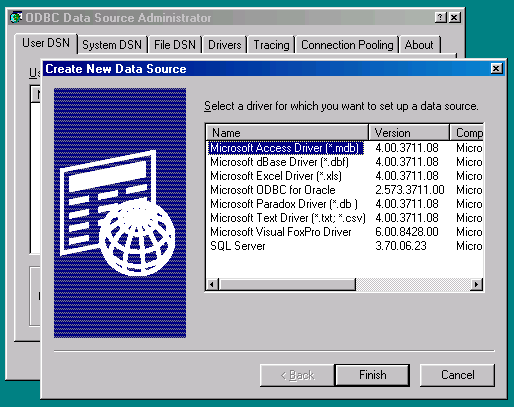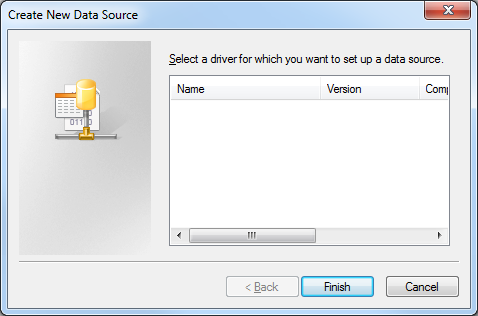Dec 20, 2017 Solution: Need to download the ODBC Driver for Microsoft Access Database. See if this will help. Run C:WINDOWSSysWOW64odbcad32.exe. This should bring the odbc Data source administrator (see if you have the 32 bit drivers listed for Microsoft access ) if you see it, set up your DSN.
- Where to download and install Microsoft Access dBASE Driver (.dbf,.ndx,.mdx)RSS 7 replies Last post Apr 26, 2013 07:09 PM by carlosgrtij.
- DBASE was one of the original database management systems and the dBASE file format (.dbf) has been around for a long time. Microsoft Access supports importing from and linking to the following dBASE file formats: dBASE III, dBASE IV, dBASE 5, and dBASE 7.
Microsoft Access Database Driver Download
dBASE was one of the original database management systems and the dBASE file format (.dbf) has been around for a long time. Microsoft Access supports importing from and linking to the following dBASE file formats: dBASE III, dBASE IV, dBASE 5, and dBASE 7.
Note dBASE support has the following requirements:
Office 365 subscription If you are an Office 365 subscriber, make sure you have the latest version of Office. If you are an IT professional managing the Office 365 update process, check out the channel releases page to learn which updates are provided in each channel
Office 2016 Install the following updates in order: May 2, 2017, update for Office 2016 (KB3115501) and May 2, 2017, update for Access 2016 (KB3178700).
Office 2016 Click-to-Run editions Updates are automatically applied.
Import data from a dBASE file
Select External Data, in the Import & Link group select More, and then select dBASE file.
In the Get External Data – dBASE File dialog box, select Browse.
In the File Open dialog box, locate the dBASE file, and then click Open.
The default file format is dBASE III. To change to dBASE IV or dBASE 5, select a file format from the drop-down list next to the File name box. Although dBASE 7 is not listed, dBASE 5 and DBASE 7 are essentially the same file format. In Access for Office 365 and Access 2019, file names of up to 64 characters are supported.
In the Get External Data – dBASE File dialog box, select Import the source data into a new table in the current database., and then select OK.
Optionally, save the import steps. For more information, see Run a saved import or export operation.
As a result, a table is created with the dBASE data. If there are no column headers in the dBASE file, Access creates default column headers.
Link to data in a dBASE file

Select External Data, in the Import & Link group select More, and then select dBASE file.
In the Get External Data – dBASE File dialog box, select Browse.
The default file format is dBASE III. To change to dBASE IV or dBASE 5, select a file format from the drop-down list next to the File name box. Although dBASE 7 is not listed, dBASE 5 and DBASE 7 are essentially the same file format. In Access for Office 365 and Access 2019, file names of up to 64 characters are supported.
In the File Open dialog box, locate the dBASE file, and then click Open.
In Access for Office 365 and Access 2019, file names of up to 64 characters are supported.
In the Get External Data – dBASE file dialog box, select Link to the data source by creating a linked table., and then select OK.
As a result, a linked table is created with the dBASE data. If there are no column headers in the dBASE file, Access creates default column headers in the linked table.
Access 2013 doesn't support dBASE
Linking to or importing from dBASE is not supported in Access 2013. To work with dBASE files, consider upgrading to an Office 365 subscription. Linking to or importing from dBASE is available in the Office 365 subscription versions of Access.
Import data from a dBASE file
Select External Data, in the Import & Link group select More, and then select dBASE file.
In the Get External Data – dBASE File dialog box, select Browse.
In the File Open dialog box, locate the dBASE file, and then click Open.
The default file format is dBASE III. To change to dBASE IV or dBASE 5, select a file format from the drop-down list next to the File name box. Although dBASE 7 is not listed, dBASE 5 and DBASE 7 are essentially the same file format.
In the Get External Data – dBASE File dialog box, select Import the source data into a new table in the current database., and then select OK.
Optionally, save the import steps. For more information, see Run a saved import or export operation.
As a result, a table is created with the dBASE data. If there are no column headers in the dBASE file, Access creates default column headers.
Link to data in a dBASE file
Select External Data, in the Import & Link group select More, and then select dBASE file.
In the Get External Data – dBASE File dialog box, select Browse.
In the File Open dialog box, locate the dBASE file, and then click Open.
The default file format is dBASE III. To change to dBASE IV or dBASE 5, select a file format from the drop-down list next to the File name box. Although dBASE 7 is not listed, dBASE 5 and DBASE 7 are essentially the same file format.
In the Get External Data – dBASE File dialog box, select Link to the data source by creating a linked table., and then select OK.
As a result, a linked table is created with the dBASE data. If there are no column headers in the dBASE file, Access creates default column headers in the linked table.

Select External Data, in the Import & Link group select More, and then select dBASE file.
In the Get External Data – dBASE File dialog box, select Browse.
The default file format is dBASE III. To change to dBASE IV or dBASE 5, select a file format from the drop-down list next to the File name box. Although dBASE 7 is not listed, dBASE 5 and DBASE 7 are essentially the same file format. In Access for Office 365 and Access 2019, file names of up to 64 characters are supported.
In the File Open dialog box, locate the dBASE file, and then click Open.
In Access for Office 365 and Access 2019, file names of up to 64 characters are supported.
In the Get External Data – dBASE file dialog box, select Link to the data source by creating a linked table., and then select OK.
As a result, a linked table is created with the dBASE data. If there are no column headers in the dBASE file, Access creates default column headers in the linked table.
Access 2013 doesn't support dBASE
Linking to or importing from dBASE is not supported in Access 2013. To work with dBASE files, consider upgrading to an Office 365 subscription. Linking to or importing from dBASE is available in the Office 365 subscription versions of Access.
Import data from a dBASE file
Select External Data, in the Import & Link group select More, and then select dBASE file.
In the Get External Data – dBASE File dialog box, select Browse.
In the File Open dialog box, locate the dBASE file, and then click Open.
The default file format is dBASE III. To change to dBASE IV or dBASE 5, select a file format from the drop-down list next to the File name box. Although dBASE 7 is not listed, dBASE 5 and DBASE 7 are essentially the same file format.
In the Get External Data – dBASE File dialog box, select Import the source data into a new table in the current database., and then select OK.
Optionally, save the import steps. For more information, see Run a saved import or export operation.
As a result, a table is created with the dBASE data. If there are no column headers in the dBASE file, Access creates default column headers.
Link to data in a dBASE file
Select External Data, in the Import & Link group select More, and then select dBASE file.
In the Get External Data – dBASE File dialog box, select Browse.
In the File Open dialog box, locate the dBASE file, and then click Open.
The default file format is dBASE III. To change to dBASE IV or dBASE 5, select a file format from the drop-down list next to the File name box. Although dBASE 7 is not listed, dBASE 5 and DBASE 7 are essentially the same file format.
In the Get External Data – dBASE File dialog box, select Link to the data source by creating a linked table., and then select OK.
As a result, a linked table is created with the dBASE data. If there are no column headers in the dBASE file, Access creates default column headers in the linked table.
Ms Access Dbase Driver Download
-->Install Microsoft Access Odbc Driver
Drivers are libraries that implement the functions in the ODBC API. Each driver is specific to a particular database management system (DBMS). In most cases, drivers expose the capabilities of the underlying DBMS; they are not required to implement capabilities not supported by the DBMS. Drivers perform specific tasks and can be classified into two categories: file-based and DBMS-based. For more information about drivers and driver architecture, see Drivers.
Ms Access Odbc Driver Install
This section contains the following topics.
